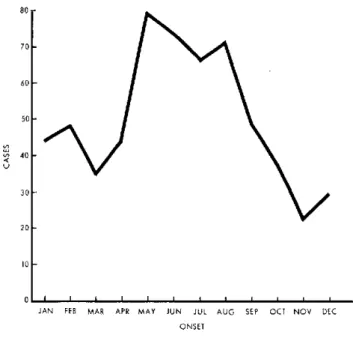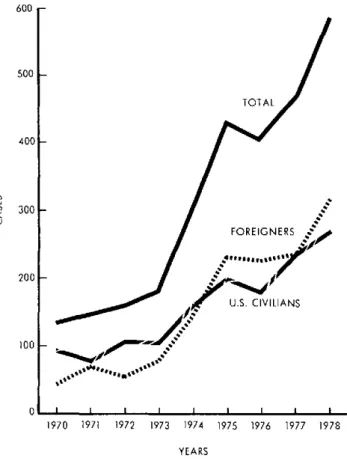Smallpox Rumors
Between 1 January 1978 and 7 November 1979, the World Health Organization received a total of 101 rumors of smallpox cases from 40 countries in which eradication had already been certified or which were
con-sidered free of the disease (Table). Apart from two cases resulting from a laboratory outbreak in the United Kingdom in 1978, none of the rumors were confirmed. Five rumors still pending are under investigation.
Summary of smallpox rumors received at WHO Headquarters, 1 January 1978-7 November 1979.
Diagnostic
False reports/ Varicella Other skin earlier
Region Year Smallpox Monkeypox or measles diseases smallpox Pending Total
Africa 1978 - 1 2 - 7 - 10
1979 - - 4 2 3 1 10
Americas 1978 - - 2 - - - 2
1979 - - 4 - 2 1 7
Eastern 1978 - - I1 2 2 - 5
Mediterranean 1979 - - I1 1 3 1 6
Europe 1978 2a -1 - 1 - 4
1979 - - 3 1 - 1 5
Southeast 1978 - - 19 2 3 - 24
Asia 1979 - - 9 7 5 1 22
Western 1978 - - - - 2 - 2
Pacific 1979 - - 2 - 2 - 4
Total 1978 2a 1 25 4 15 - 47
1979 - - 23 11 15 5b 54
aTwo cases of smallpox originating in a laboratory in the United Kingdom, August 1978.
bThe rumors pending are those that were reported to Geneva Headquarters during the two weeks prior to 7 November and that are being in-vestigated.
-None.
Malaria in the United States, 1978
2D,.
CIn 1978, 616 cases* of malaria were reported in the United States, a 28.3 per cent increase over the 481 cases reported in 1977.
Only 31 cases (5.1 per cent of all cases reported in the United States) were in military personnel.
*A "case" is defined as an individual's first attack of malaria in tihe United States, regardless of whether or not he had experienced pre-vious attacks of malaria while outside the country. A subsequent attack in the same person caused by a different Plasrlodiul species is counted as an additional case. Repeated attacks in the United States caused by the same species are considered relapses, not additional
As in previous years, imported Plasmodium vivax
cases were more common than those of P. falciparum
(64.1 per cent as compared to 19.4 per cent).l No local transmission by mosquitoes was reported. In 1978 there were 6 reported deaths attributed to
cases. All cases included in this report wvere diagnosed as malaria on the basis of a positive peripheral blood smear examined in the local or state health department laboratory. Doubtful cases were referred to the National Malaria Repository of the U.S. Center for Disease Control in Atlanita, Georgia.
7
malaria compared with 3 in 1977; 5 were due to P. falciparum and 1 to P. malariae.
The fatality rate of malaria caused by P. falciparum
was 4 per cent; the rate for the 10-year period 1966-1975 was 1.6 per cent.
In 6 of the 585 civilian cases (none in military per-sonnel) the patients acquired the disease in the United States. Three cases were transfusion-induced-1 each of P. falciparum, P. vivax, and P. malariae. Two con-genital cases occurred-P. falciparum and P. vivax. In 1 case, the infection followed a kidney transplant.
Although the 31 cases in military personnel in 1978 represented an increase of 282 per cent over 1977 (11 cases), the total number of cases in military personnel remained far below the levels seen during the Vietnam War years (maximum of 4,096 in 1970).
The proportion of cases caused by each Plasmodium
species showed little change between 1977 and 1978 (Table 1).
Of the 616 cases, the percentages of patients by place in which malaria was contracted were as follows: 52.1 in Asia; 28.9 in Africa; 12.0 in Central America and the Caribbean areas; 2.2 in South America; 1.8 in Oceania; and 3.0 in North America. The number of reported malaria cases contracted in Asia for 1978 rep-resents a 22.9 per cent increase over that for 1977, which reflects a marked increase in the number of cases from India-241 in 1978 as against 188 in 1977. As in 1977, the largest number of cases in 1978 originated in India and represented 39.4 per cent of all cases.
Of the imported cases, a large number of patients acquired the disease in Nigeria (47), the Philippines (24), Kenya (17), El Salvador (16), Ghana (15), and Honduras (15).
In 1978, as in the preceding year, the seasonal distribution of malaria cases-excluding those whose date of onset was unknown-showed a distinct pattern: a definite peak was apparent in late spring and during the summer months (Fig. 1).
This seasonal distribution pattern probably reflects the increase in travel of North Americans during the summer months.
Table 1. Malaria cases by Plasmodium species,
United States, 1978.
Species Total %
P. vivax 395 64.1
P. falciparum 120 19.4
P. malariae 43 7.0
P. ovale 14 2.3
Mixed infections 3 0.5
Undetermined 41 6.7
Total 616 100.0
Figure 1. Cases of malaria, by month of onset, United States, 1978.
80
70
60
50
V
40
30
20
Io
JAN FEB MAR APR MAY JUN JUL AUG SEP OCT NOV DEC ONSET
In cases for which the exact dates of arrival in the United States and of onset were available, the clinical symptoms of malaria developed within 30 days of arrival in the United States in 79.5 per cent of individuals with
P. falciparum malaria and in 30.9 per cent of those with
P. vivax malaria.
Within six months of returning to the United States 96.2 per cent of patients with P. falciparum malaria and 70.2 per cent of those with P. vivax malaria de-veloped clinical symptoms.
Twenty-one patients (4.1 per cent) became ill with malaria 12 months or longer after their exposure to the disease abroad. Of the 603 cases on which complete in-formation was available, 86.6 per cent required hospital-ization.
Most of the patients (65.5 per cent) were initially treated in civilian hospitals, 5.0 per cent in military hospitals, and 1.5 per cent in U.S. Public Health Service hospitals. The armed forces and Veterans' Administra-tion have made malaria reporting a major responsibility
of their hospital staffs. Although malaria is a reportable disease in every state, reporting by civilian physicians is largely a matter of individual initiative, thus the per-centages mentioned above probably underestimate the extent to which civilian physicians saw patients with
malaria.
The number of imported civilian cases continued to increase in 1978 (Fig. 2). This trend has been evident for the last 10 years, but was masked by the large number of military cases during the Vietnam War years. The
one-8
0
Figure 2. Cases of malaria in U.S. civilians and foreigners, United States, 1970-1978.
600
-500
1-TOTAL
400
-u 300
quarter increase in the United States and foreign civilian cases between 1977 and 1978 brought the number to 585. However, the percentage distribution of cases, by pur-pose of travel in malarious areas, has shown no appreci-able change in the past 10 years.
The 1978 data show that, of the American and foreign civilians who acquired malaria, most were students and teachers (23.7 per cent), but tourists (9 per cent) and businessmen (7.4 per cent) also accounted for a signifi-cant proportion of cases.
The distribution of cases by age and sex shows that, as in earlier years, males between 20 and 29 years of age accounted for the largest number of cases.
(Based on Malaria Surveillance Annual Summary 1978, Center for Disease Control, Atlanta, Georgia. Published in August 1979.)
200
1-
100oo-o
1970 1971 1972 1973 1974 1975 1976 1977 1978
YEARS
utbreak
of
Meningooal
DEMeningitis
in
Osorno,
Chile
Outbreak of Meningococcal Meningitis in Osorno, Chile
rIn mid-July 1979, an epidemic outbreak of menin-gococcal meningitis occurred in the city of Osorno and peaked in the following month. Following a mass vac-cination campaign carried out in mid-August, the out-break was brought under control (see Figure). A total of 39 cases was reported, which represents a rate of 21.7 per 100,000 inhabitants, compared with a rate of 1.1 per 100,000 recorded in nonepidemic years.;~
The age groups most affected were u4weaned and school age children (Table 1).
Most of the cases occurred in the suburb of Rahue
Alto in the city of Osorno. In the remainder of the Province of Osorno,* which consists mostly of rural areas, only 7 cases occurred, which represents a rate of 3.9 per 100,000 inhabitants.
Of the 39 cases recorded in the Province of Osorno, 31 were confirmed bacteriologically by culture, and typing showed that all were due to strain A. In 6 cases,' the diagnosis was made by Gram staining of
cerebro-*In Chile, the Province of Osorno nmust be distinguished froni the provincial capital of Osorno.
9
1 1 1 1 1 1 1

